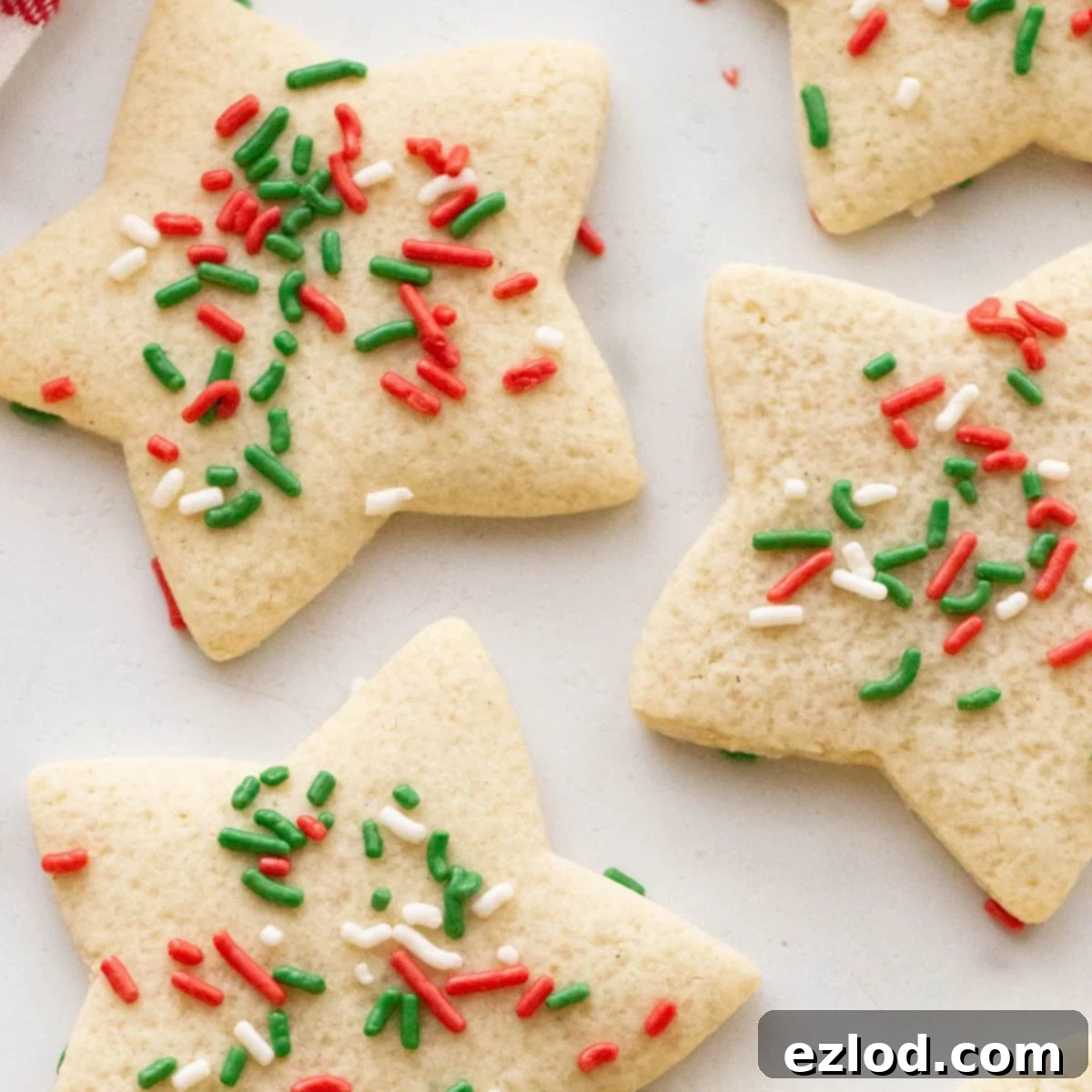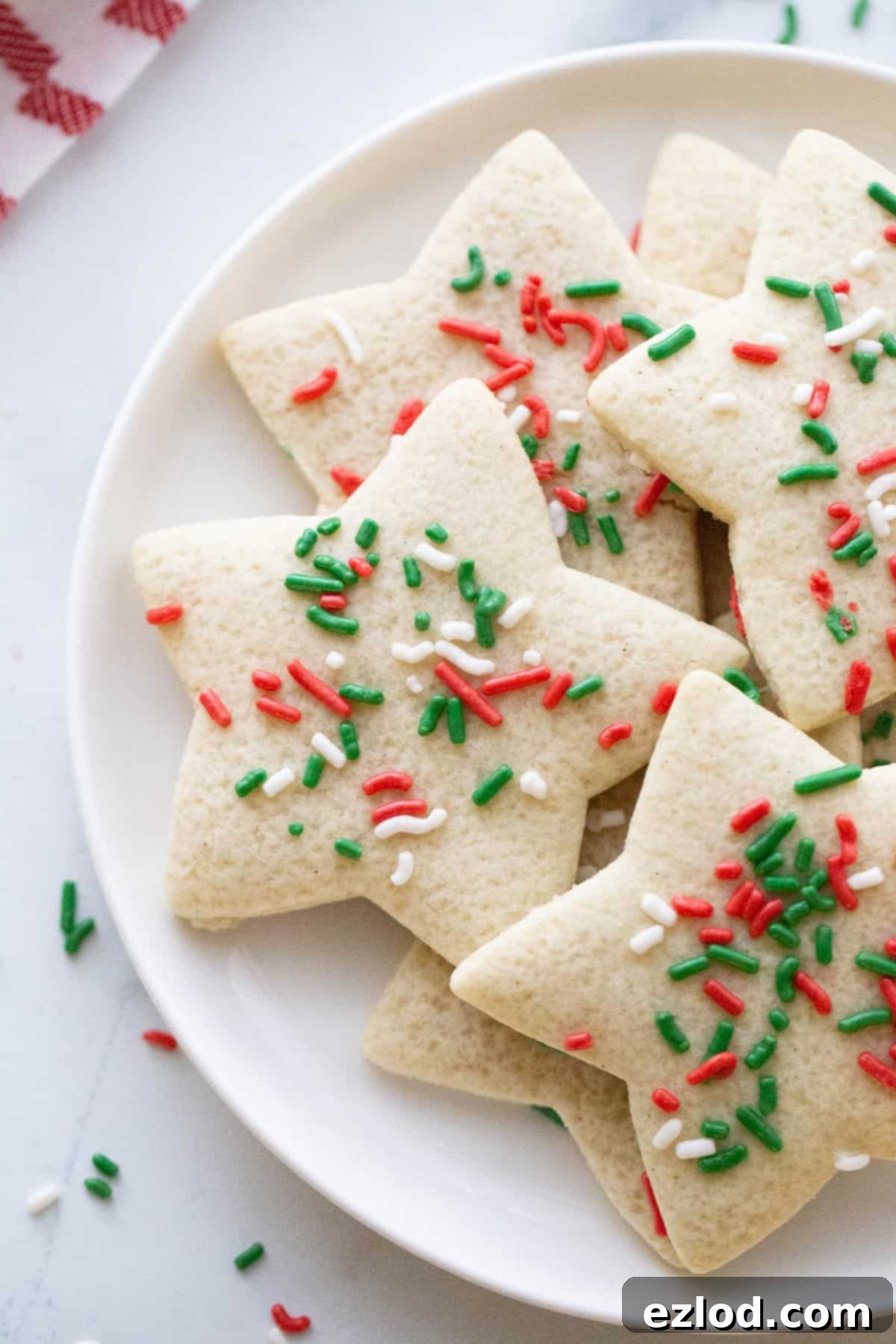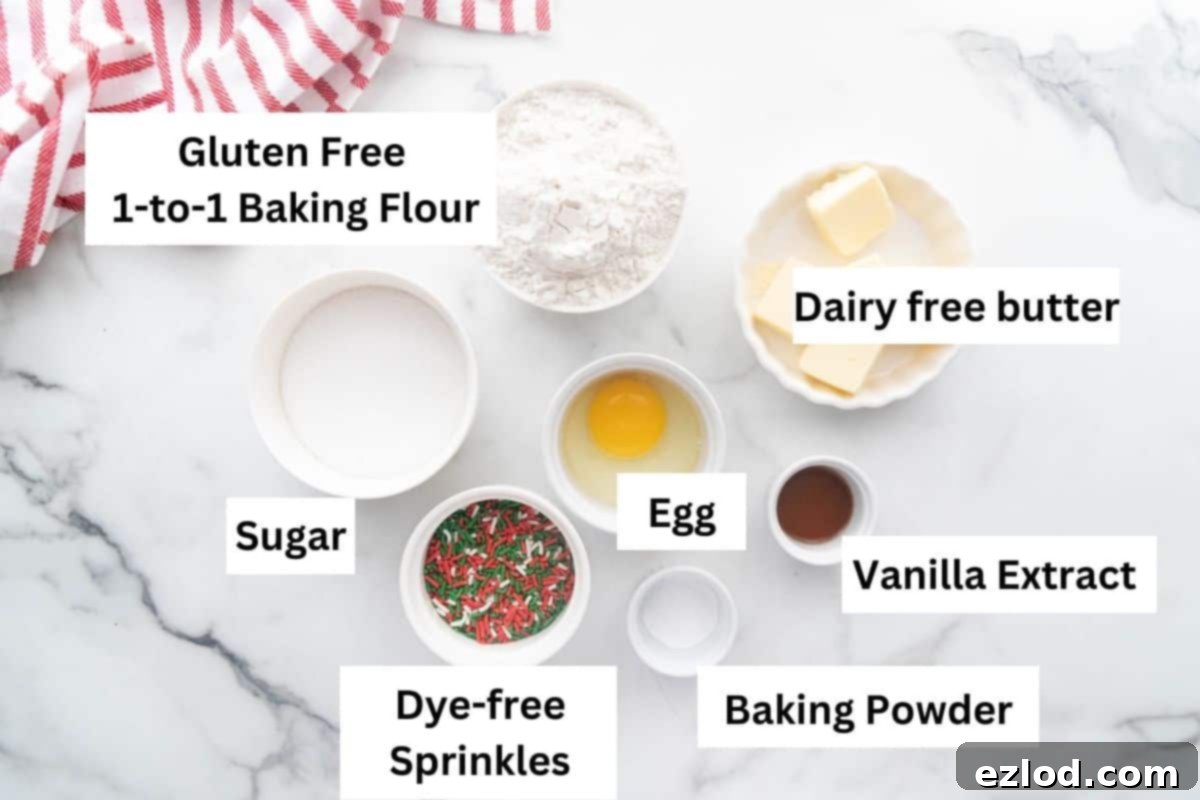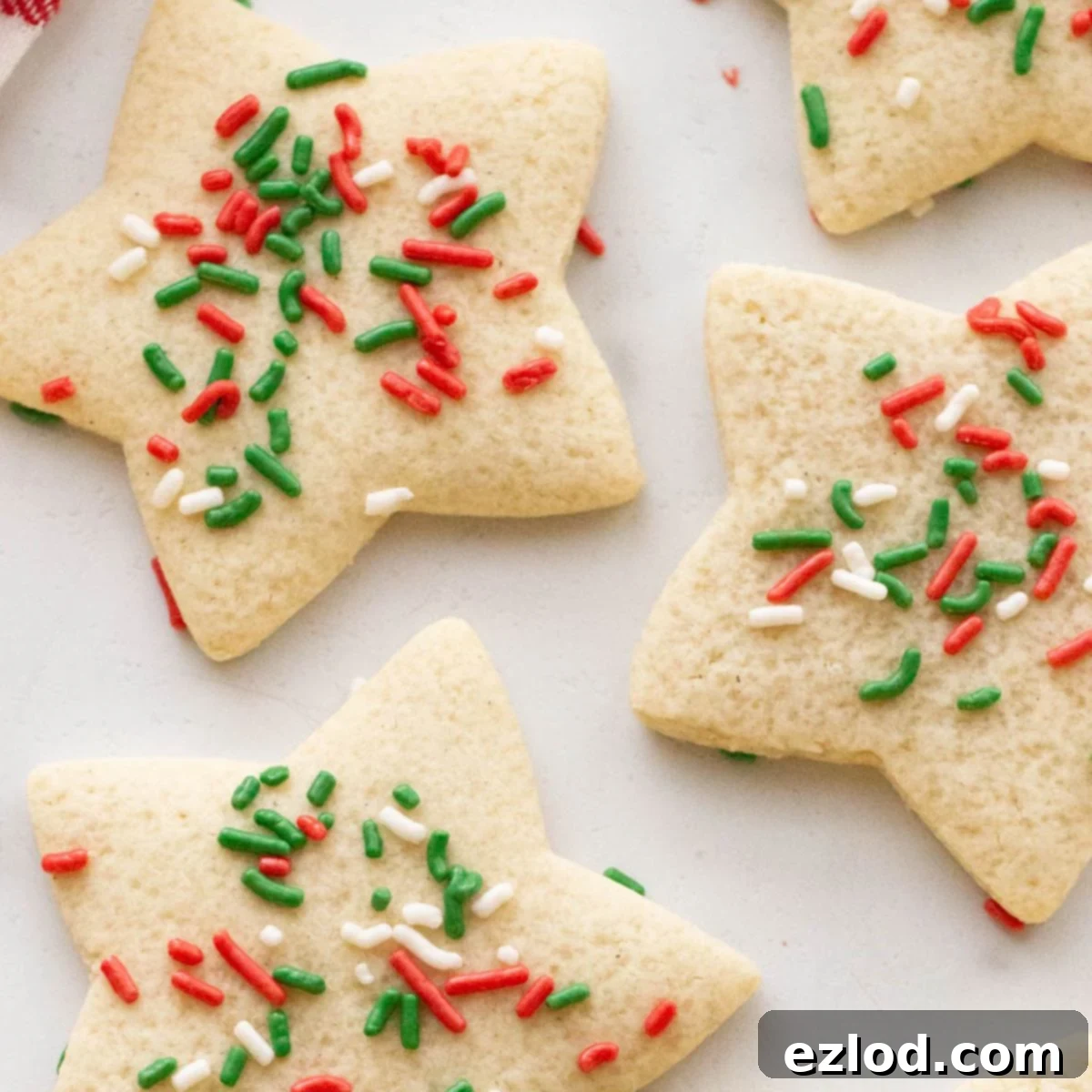Delicious Gluten-Free Dairy-Free Sugar Cookies: A Healthier Recipe for All Occasions
Craving something sweet but sticking to a gluten-free and dairy-free diet? Look no further! This incredible recipe for healthier sugar cookies is not only delicious but also caters to your dietary needs without compromising on flavor or fun. Perfect for holiday celebrations, special events, or simply satisfying that sweet tooth, these easy-to-make cookies are a guilt-free pleasure everyone can enjoy.

For years, I dreamt of creating a dairy-free and gluten-free sugar cookie recipe that also offered a healthier twist, complete with 21 Day Fix Container Counts. This dream became a reality during a quiet November, inspired by days spent at home. I embarked on a baking adventure, utilizing my favorite gluten-free flour blend and consciously reducing the butter and sugar typically found in traditional sugar cookie recipes. The goal was to achieve that classic sugar cookie taste and texture, but with a nutritional boost, making them a more mindful indulgence.
The first batch was an instant hit. My kids, who are usually discerning cookie critics, devoured them almost immediately and declared them “delicious!” Their enthusiastic approval was all the motivation I needed. Now, I’m thrilled to share these delightful cutout sugar cookies with you, complete with easy-to-understand container counts for the 21 Day Fix. And the best part? These aren’t just a “treat swap”; they’re a genuinely healthier option that you can enjoy without guilt, making them a fantastic addition to any balanced eating plan, especially during festive seasons or when a sweet craving strikes.

Table of Contents
Toggle
Why You’ll Love These Healthier Sugar Cookies
These healthier gluten-free and dairy-free sugar cookies aren’t just another recipe; they’re a delightful solution for anyone seeking delicious treats that align with specific dietary needs. Here’s why this recipe has become a personal favorite and why I believe you’ll adore it too:
- Truly Allergy-Friendly: They are crafted to be both gluten-free and dairy-free, making them suitable for those with sensitivities or allergies. This means no more feeling left out during cookie season! However, if dairy isn’t an issue for you, feel free to use traditional unsalted butter for an equally delightful result. The flexibility of this recipe ensures it can be enjoyed by a wider audience, catering to various dietary preferences.
- “Containerized” for the 21 Day Fix: I’ve meticulously calculated the container counts for the 21 Day Fix program, making it incredibly easy to incorporate these cookies into your meal plan. Unlike many other treats, you can actually enjoy more than one cookie without feeling like you’ve completely derailed your healthy eating goals. This makes them a smart and satisfying choice for those following structured eating plans, proving that you don’t have to sacrifice taste for health.
- Kid-Approved Taste: Despite being “healthier,” these cutout cookies taste so good that even my pickiest eaters (my kids!) absolutely adore them. Their seal of approval means these are perfect for Christmas cookies, birthday parties, or any special occasion where you want to serve a crowd-pleasing dessert that happens to be allergy-friendly. The classic sugar cookie flavor and tender texture ensure they’re a hit with everyone, regardless of dietary needs.
- Effortless Dough to Work With: Say goodbye to frustrating, crumbly, or sticky doughs. This recipe yields a dream to work with – no lengthy chilling required! You can mix, roll, cut, and bake almost immediately, saving you precious time, especially during busy holidays. The quick preparation time means you can have warm, fresh cookies in your hands faster than ever.
- Simple Ingredients, Minimal Mess: You likely already have most of the ingredients needed right in your pantry, making this a convenient recipe to whip up anytime. Plus, everything comes together beautifully in just one bowl, significantly cutting down on cleanup time. Fewer dishes mean more time to relax and enjoy your delicious creations with loved ones.
Do you have friends or family members who follow a gluten-free and dairy-free diet? These cookies make a thoughtful and delicious homemade gift, showing them you care about their dietary needs and preferences. For creative presentation ideas, check out this post on how to create the ultimate cookie gift box and truly impress them with your baking prowess and thoughtfulness.
If you’re eager for more dairy-free and gluten-free cookie inspiration, be sure to explore my collection of favorite Gluten and Dairy Free Christmas Cookies! These recipes offer a variety of flavors and textures, all designed to be inclusive and incredibly tasty.
Essential Kitchen Equipment
Having the right tools can make all the difference in your baking experience. For these delightful cookies, a few key pieces of equipment will ensure a smooth and enjoyable process, from mixing to cooling, ultimately leading to perfectly baked treats.
- Parchment Paper: This is a baker’s best friend! It prevents the dough from sticking to your rolling surface, makes cleanup a breeze, and allows for easy transfer of delicate cookie cutouts to the baking sheet. You’ll use it for both rolling out the dough and lining your baking sheets.
- Electric Mixer (Hand or Stand Mixer): Essential for properly creaming the softened butter and sugar, as well as thoroughly combining all ingredients. A good mixer ensures a light, airy dough that results in tender, soft, and delicious cookies. While a stand mixer offers convenience, a hand mixer works just as well.
- Rolling Pin: To achieve an even thickness for your cutout cookies. Uniform thickness is crucial for consistent baking; thin spots will burn, while thick spots will remain undercooked.
- Cookie Cutters: The fun part! Choose your favorite shapes to match any occasion, be it stars for holidays or simple circles for everyday treats. If you don’t have traditional cookie cutters, a small drinking glass, a shot glass, or even a tiny bowl can be used to cut out simple round shapes.
- Baking Sheets: Sturdy, light-colored baking sheets are crucial for even heat distribution and consistent baking. Darker sheets can sometimes cause the bottom of cookies to brown too quickly.
- Wire Cooling Rack: Allows air to circulate all around the cookies once they come out of the oven. This prevents them from getting soggy on the bottom due to trapped steam and ensures they cool completely, maintaining their crisp edges and soft centers.
Key Ingredients for Perfect Cookies
Crafting these healthier gluten-free and dairy-free sugar cookies requires a few simple yet essential ingredients. Each component plays a vital role in achieving the desired taste, texture, and overall success of the recipe. Below, you’ll find details on what to use and helpful tips for successful baking. Exact measurements are available in the comprehensive recipe card at the bottom of this post.

- Dairy-Free Butter, softened: I highly recommend using a quality stick-form dairy-free butter, such as Earth’s Balance dairy-free sticks, for their excellent flavor and consistency, which mimics traditional butter beautifully. For those without dairy restrictions, regular unsalted butter can be used as a direct substitute. Ensuring your butter is properly softened (not melted!) is crucial for proper creaming with the sugar, which incorporates air and leads to a lighter, more tender cookie texture.
- Organic Sugar: While organic sugar is my preference for its quality and flavor profile, any regular granulated cane sugar will work perfectly fine. The sugar not only provides essential sweetness but also contributes significantly to the cookies’ texture. It helps them to spread slightly during baking and achieves that desirable crisp-chewy balance that defines a great sugar cookie.
- Large Egg at Room Temperature: A room temperature egg is vital for proper emulsion. It combines more smoothly and evenly with the creamed butter and sugar, resulting in a more uniform dough and a better-textured, less dense cookie. PRO TIP: If you’re in a hurry and your egg is cold, simply place it (still in its shell) in a bowl of warm water for 5-10 minutes to quickly bring it to room temperature.
- Vanilla Extract: This classic flavoring is a cornerstone of sugar cookies, adding a warm, aromatic depth that is both comforting and delicious. If you’re looking to experiment with different flavor profiles, almond extract makes an excellent substitute, offering a slightly more pronounced, nutty aroma that complements the sweetness beautifully. Feel free to use a combination of both for a unique twist.
- Gluten-Free 1:1 Baking Flour: The type of gluten-free flour blend you use is absolutely key to the success of this recipe. I consistently rely on Bob’s Red Mill 1-to-1 Baking Flour because it’s a well-balanced, all-purpose blend that already includes xanthan gum. Xanthan gum is essential in gluten-free baking as it provides structure and elasticity to the dough, mimicking the role of gluten and preventing crumbly cookies. If your chosen blend does not contain xanthan gum, you’ll need to add about 1/4 teaspoon per cup of flour. If you are not gluten-free, standard all-purpose flour can be substituted seamlessly. Remember to measure flour by spooning it into the measuring cup and leveling it off, rather than scooping directly, to avoid packing too much flour.
- Salt: A pinch of salt is incredibly vital for enhancing and balancing the sweetness of the cookies, bringing out all the subtle flavors and preventing them from tasting overly sugary. If you’re using a dairy-free butter alternative, always taste it first or check its label; some dairy-free butters are already salted, in which case you might want to omit or reduce the added salt to avoid overly salty cookies.
- Baking Soda: This leavening agent is responsible for the slight rise and tender texture of the cookies. For the best baking results, always ensure your baking soda is fresh. It typically lasts for about 6-12 months once opened, so if it’s been in your pantry for a while, it’s best to replace it.
- Dye-Free Sprinkles or Regular Sprinkles (Optional): Sprinkles are entirely optional but add a delightful festive touch, a pop of color, and a subtle crunch that enhances the cookie experience. I personally love using this brand of dye-free sprinkles for a cleaner ingredient list, especially when baking for kids. However, any regular sprinkles will work perfectly, or you can opt to leave them out entirely for a simpler, elegant sugar cookie.
Step-by-Step Baking Instructions
Making these healthier gluten-free and dairy-free sugar cookies is a straightforward and enjoyable process. Follow these detailed steps to bake a batch of perfect, tender cookies every time. Read through all the instructions before you begin to ensure a smooth baking experience.
- Preheat your oven: Begin by preheating your oven to 350 degrees F (175 degrees C). This ensures the oven is at the correct, consistent temperature for even baking as soon as your cookies are ready to go in.
- Cream the butter and sugar: In a large mixing bowl, using an electric mixer (either hand-held or a stand mixer with the paddle attachment), beat together the softened dairy-free butter (or regular unsalted butter) and organic sugar on medium-low speed. Continue beating for approximately 2 minutes, or until the mixture is light, fluffy, and thoroughly combined. This creaming step is crucial as it incorporates air, which contributes to a tender, delicate cookie.
- Combine wet and dry ingredients: Add the room temperature egg and vanilla extract to the creamed mixture. Beat these wet ingredients until they are fully incorporated and the mixture is smooth. Next, gradually add the dry ingredients – the gluten-free 1:1 baking flour, salt (if using), and baking soda – to the bowl. Mix on low speed until everything is just combined and a soft, cohesive dough ball forms. Be careful not to overmix at this stage, as over-mixing can develop the starches in the gluten-free flour, potentially leading to tougher cookies.
- Roll out the dough: Cut two generous pieces of parchment paper. Place your dough ball between these two sheets of parchment paper. Using a rolling pin, gently and evenly roll out the sugar cookie dough until it is approximately ¼ to ⅛ inch thick. Aim for consistent thickness across the entire sheet of dough to ensure all cookies bake evenly. Avoid rolling the dough too thin, as this can result in overly crispy or easily breakable cookies; we want them to be tender with a slight chew.
- Prepare for cutting: Carefully peel off and remove the top sheet of parchment paper from the rolled dough, setting it aside for later use or another batch. Your rolled dough should now be resting on the bottom parchment, ready for cutting.
- Cut and decorate cookies: Now for the fun part! Using your favorite cookie cutters (or a small drinking glass for simple circular shapes), press firmly to cut out your desired cookie shapes from the rolled dough. Carefully remove the excess dough from around the cutouts. Gather this excess dough, lightly press it back together, wrap it tightly in plastic wrap, and place it in the fridge while your first batch bakes. This helps keep the dough firm and easy to work with for re-rolling. If desired, sprinkle your cut-out cookies with dye-free or regular sprinkles for a decorative and festive touch before they go into the oven.
- Transfer to baking sheet: This is a crucial step for maintaining perfect cookie shapes. Instead of trying to lift each delicate cookie individually from the parchment paper, simply keep the cookies precisely where they are on the bottom parchment sheet. Carefully slide this entire parchment sheet, with the cut-out cookies neatly arranged on it, directly onto a sturdy baking sheet. This minimizes handling, preventing stretching or distorting the cookie shapes.
- Bake the cookies: Place the baking sheet with your prepared cookies into the preheated oven. Bake for approximately 6 minutes. You’ll know they’re done when they appear cooked through, and the very edges look just a tiny bit crispy. It’s crucial not to let them brown at all; over-baking will make them excessively crunchy and lose their tender quality once cooled. We’re aiming for a soft, tender center with just a hint of crispness at the edges.
- Cooling process: Once baked to perfection, remove the cookies from the oven. Let them cool directly on the hot baking sheet for about 3 minutes. This allows them to firm up slightly, making them easier to handle without breaking. After 3 minutes, carefully transfer the cookies (still on their parchment paper if preferred, or directly) to a wire cooling rack to cool completely. Cooling on a rack allows air circulation around all sides, preventing condensation and ensuring they retain their desired texture.
- Repeat and reuse: Once your first batch is cooled and removed, retrieve the chilled excess dough from the fridge. Re-roll it between fresh sheets of parchment paper (or reuse the existing ones to minimize waste, if they are clean and intact). Repeat the cutting and baking process until all the dough is used. This method ensures you get the most cookies out of your dough while maintaining consistent quality.
Meal Prep & Storage Tips
These healthier gluten-free and dairy-free sugar cookies are fantastic for making ahead and storing, ensuring you always have a delicious treat on hand for unexpected guests, a quick snack, or holiday festivities. Proper storage will help maintain their freshness and delightful texture for longer.
- To Prep Ahead (Dough): One of the best features of this recipe is its make-ahead potential! You can easily prepare the cookie dough in advance. Once the dough ball is formed as per the instructions, cover it tightly with plastic wrap or place it in an airtight container. Store it in the refrigerator for up to 3-4 days. When you’re ready to bake, simply remove the dough from the fridge and let it sit at room temperature for about 10-15 minutes to soften slightly, making it easier to roll and cut. This method significantly streamlines holiday baking or entertaining.
- To Store (Baked Cookies): Once completely cooled, it’s crucial to store your baked cookies properly to maintain their freshness. Place them in an airtight container at room temperature. There’s absolutely no need to refrigerate them, as this can sometimes dry them out. For optimal freshness, you can also place them in gallon-sized ziplock bags, carefully pressing out as much excess air as possible before sealing. Stored correctly, these delicious cookies should remain fresh, soft, and delightful for up to two weeks, though in most households, they rarely last that long!
- To Freeze (Baked Cookies): These cookies freeze beautifully, making them perfect for future cravings or for preparing large batches for events. To freeze, first ensure the cookies are completely cooled. Arrange them in a single layer on a parchment-lined baking sheet and flash freeze them for about 1-2 hours, or until they are solid. This prevents them from sticking together in the freezer. Once flash-frozen, transfer the solid cookies to a freezer-safe airtight container or a heavy-duty gallon-sized ziplock bag. They will keep exceptionally well in the freezer for 3-5 months. When a cookie craving strikes, simply remove them from the freezer and let them thaw on the counter for the best texture and enjoyment. They’ll taste almost as fresh as the day they were baked!
Frequently Asked Questions (FAQs)
Here are answers to some common questions you might have about making and customizing these healthier gluten-free and dairy-free sugar cookies:
Unfortunately, neither almond flour nor coconut flour can be directly substituted in this recipe. While both are gluten-free, they have vastly different absorption rates, protein content, and structural properties compared to a 1:1 gluten-free baking blend. Using them would drastically alter the cookie’s texture, consistency, and moisture balance. For instance, coconut flour is extremely absorbent, and almond flour lacks the same binding properties. If you’re keen on using these specific flours, I highly recommend finding a recipe specifically developed for them to ensure successful results. For example, I love these No Bake Peanut Butter Cookies made with coconut flour, and these delicious Gluten Free Chocolate Chip Cookies which utilize almond flour beautifully.
While I haven’t specifically tested this recipe as drop cookies, the dough is designed for rolling and cutting to achieve that classic sugar cookie shape and a more uniform texture. If made as drop cookies, they might spread more and result in a different, possibly less uniform, texture. However, if you don’t have cookie cutters, don’t fret! You can easily get creative: use a small drinking glass, a shot glass, or even a tiny bowl to cut out perfectly circular shapes. For a rustic look, you could also hand-roll small balls and gently flatten them slightly with the palm of your hand or a fork, though they might not hold a perfect “sugar cookie” shape and may bake differently. I plan to test a drop cookie version in the future and will update this post with my findings!
This recipe calls for one egg, which plays a critical role in the cookie’s structure, binding, and moisture. While you could attempt to use an egg replacer (such as a flax egg or commercial egg substitute), I haven’t personally tried an egg-free version of this specific recipe and therefore cannot guarantee the same results in terms of texture, consistency, and overall success. Eggs are vital for achieving the desired chewiness and preventing the cookies from becoming too crumbly. If you’re looking for a reliably vegan sugar cookie, I would highly recommend seeking out a recipe specifically developed for that purpose. You might find great success with a dedicated vegan and gluten-free sugar cookie recipe from a trusted vegan baking resource. If you do decide to experiment with an egg replacer here, please let us know how it turns out in the comments below!
Several factors can contribute to cookies that turn out crispy rather than soft and tender. The most common reasons include rolling the dough too thin (aim for ¼ to ⅛ inch thickness – thinner dough bakes faster and becomes crispier) or overbaking. Keep a close eye on your cookies in the oven; they should look just set and very lightly golden at the edges, but crucially, not browned. Oven temperatures can vary significantly, so the 6-minute baking time is a guideline. If your oven runs hot, you might need to reduce the baking time by a minute or two. Also, ensure your dry ingredients, especially the flour, are properly measured using the spoon-and-level method, as too much flour can lead to a drier, crispier cookie. For soft cookies, err on the side of slightly underbaked rather than overbaked.
Absolutely! These healthier gluten-free and dairy-free sugar cookies make a wonderful canvas for frosting and decorating. Once the cookies are completely cooled (which is essential to prevent the frosting from melting), you can decorate them with your favorite dairy-free royal icing, a simple powdered sugar glaze, or a healthier buttercream made with dairy-free butter. This is especially fun for holidays, birthdays, or themed parties, allowing for endless creative possibilities to make your cookies even more special and personalized!
More Allergy-Friendly Cookie Recipes
If you’re loving these healthier sugar cookies and are looking for more delicious treats that accommodate gluten and dairy sensitivities, you’re in luck! Explore these other fantastic allergy-friendly cookie recipes from my kitchen that are perfect for satisfying any sweet craving:
- Healthy Thin Mints
- Gluten Free Monster Cookies [Dairy Free]
- Healthy Samoas Cookie Bars [Gluten Free]
- No Bake Peanut Butter Cookies [Vegan | GF]
- Easy Chocolate Macaroons [Allergy Friendly]
- Gluten Free Chocolate Chip Cookies

Gluten Free Dairy Free Sugar Cookies Recipe Card
Pin Recipe
Equipment
-
parchment paper
-
hand mixer
-
cookie sheet
-
cooling rack
Ingredients
- 5 Tablespoons dairy-free butter softened (e.g., Earth’s Balance sticks; use regular unsalted butter if not dairy-free)
- 1/2 cup + 2 Tablespoons organic sugar (or any regular cane sugar)
- 1 large egg (at room temperature)
- 1/2 teaspoon vanilla extract (or almond extract for a different flavor)
- 1 ½ cups gluten-free 1:1 baking flour (such as Bob’s Red Mill; spoon and level method recommended for accuracy)
- 1/4 teaspoon salt (omit if using salted dairy-free butter)
- 1/4 teaspoon baking soda
- Dye-free or regular sprinkles (optional, for decoration)
Instructions
-
Preheat your oven to 350 degrees F (175 degrees C).
-
In a large bowl, using an electric mixer, beat the softened dairy-free butter and organic sugar on medium-low speed for about 2 minutes, until light and fluffy.
-
Add the room temperature egg and vanilla extract; beat until well combined. Gradually add the gluten-free 1:1 baking flour, salt (if using), and baking soda. Beat on low speed until all ingredients are just incorporated and a cohesive dough ball forms. Do not overmix.
-
Cut two pieces of parchment paper. Place the dough between them and, using a rolling pin, roll out the dough to approximately ¼ to ⅛ inch thick. Ensure the thickness is even for uniform baking.
-
Carefully remove the top sheet of parchment paper and set it aside.
-
Using your favorite cookie cutters or a small glass, cut out your desired cookie shapes. Carefully remove the excess dough, wrap it in plastic wrap, and refrigerate it while the first batch bakes. If desired, sprinkle the cut cookies with sprinkles.
-
Instead of lifting individual cookies, keep them on the bottom parchment sheet and slide the entire sheet onto a baking sheet.
-
Bake for 6 minutes, or until the cookies appear cooked through and the edges are just slightly crispy. Avoid browning to ensure soft cookies.
-
Remove from the oven and let cool on the baking sheet for 3 minutes before carefully transferring to a wire cooling rack to cool completely.
-
Repeat the rolling, cutting, and baking process with the remaining chilled dough, reusing parchment paper to minimize waste.
Video
Notes
Weight Watchers (WW) Points: 6 points (per cookie)
Prep + Storage Guidelines:
- To Prep Ahead (Dough): Mix the dough, then cover tightly with plastic wrap and refrigerate for up to 3-4 days until ready to use.
- To Store (Baked Cookies): Keep completely cooled cookies in an airtight container or gallon-sized ziplock bags at room temperature for up to two weeks.
- To Freeze (Baked Cookies): Flash freeze cooled cookies on a lined baking sheet until solid. Transfer to a freezer-safe container or bag for 3-5 months. Thaw on the counter for best results.
Nutrition
